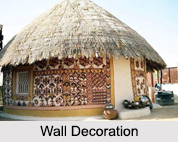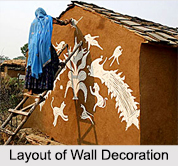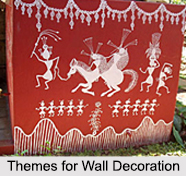 Wall Decoration among the present tribals is a common art that is mostly seen in villages. The walls of their huts are decorated with colour or symbols. Mud huts have provided an attractive surface for decoration. This flat surface has always been an inspiration for the artists. The mud wall is utilized for wall decorations on wet as well as dry-surface. They have depicted their rich tradition and conventions on the walls of their huts. The wall decoration shows their artistic awareness. It is creation which has no purpose excepting creation of beauty.
Wall Decoration among the present tribals is a common art that is mostly seen in villages. The walls of their huts are decorated with colour or symbols. Mud huts have provided an attractive surface for decoration. This flat surface has always been an inspiration for the artists. The mud wall is utilized for wall decorations on wet as well as dry-surface. They have depicted their rich tradition and conventions on the walls of their huts. The wall decoration shows their artistic awareness. It is creation which has no purpose excepting creation of beauty.
Technique of Wall Decoration
The wall decoration is a lengthy procedure. From the beginning to the end of hut-making the entire family of tribals takes part. Clay and cow dung is the most commonly used material for making walls in villages. Men complete the structure and ceiling of the house. Clay kneading, making of the wall, plastering of mud and decoration is the responsibility of women. The women have kept the folk art alive in its true sense in the villages. Wall decoration is lastly executed. It is considered as the finishing touch of the tribal hut construction.
Wall decoration is lastly executed. It is considered as the finishing touch of the tribal hut construction.
Types of Wall Decoration
Wall Decoration are of two types;
a) One or two forms are made at one or two places and the major portion of the wall remains plain. This form is generally found in the centre of the wall or by the side of door case or around niches and window.
b) The entire wall is decorated into successive frames and each panel of frame is the part of the main composition of the wall.
Layout of Wall Decoration
The woman artist surveys and plans the area of wall that needs to be decorated and begins by making a simple frame around it. These frames are simple lines or bars, occasionally enhanced with raised scrolls or incised chevrons or bone patterns. If the frame is a large one, it may be elaborated with a large variety of motifs, single or double wavy lines, loops with small projections around the belly. The area may then be further divided into panels by broad bars enhanced with geometric motifs. The objects to be portrayed are plastered within the frame or panels, generally on a slightly lower relief than the outer surrounding lines.
The area may then be further divided into panels by broad bars enhanced with geometric motifs. The objects to be portrayed are plastered within the frame or panels, generally on a slightly lower relief than the outer surrounding lines.
Themes for Wall Decoration
These decorations have two aspects – the decorative and establishment of God, Goddesses, religious and magical motifs. The decorative patterns are based on geometrical forms like circles, triangles, dots, crosses, parallel lines and wavy lines. Birds and animals are depicted. The most common animals depicted are deer, rabbit, lion, elephant, horse, peacock, bull and snake. Human figures are drawn without much detail.
The Gods and Goddesses are represented symbolically. Some of the Hindu deities like Lord Hanuman, Lord Ram and Laxman, Radha, Lord Krishna, Lord Ganesha and Goddess Durga are found in naturalistic style. Tribe`s own Gods and Goddesses are developed in symbols. The representation of clan-Gods, magical forms and signs of lightning are some of the important issues of decoration.
















